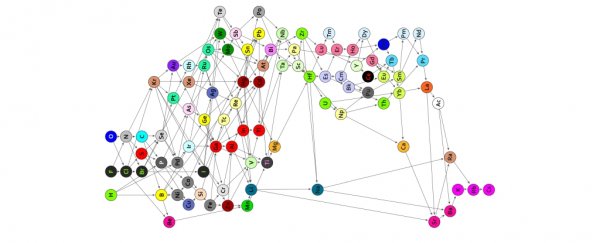The periodic table is such a comforting way of cataloguing the Universe, breaking it down into its elements and organising them in nice neat boxes. What you may not know is it's not the only way of arranging the elements - and it may not even be the best way, necessarily.
We've seen several previous weird and wonderful redesigns, often with flowy organic shapes, like spirals and curling ribbons and even a 3D "flower".
Now mathematicians at the Max Planck Institute have detailed mathematical methods for cataloguing the elements, creating a series of complex hypergraphs, rather than the more basic periodic table currently in universal use.
In this way, they say, the periodic table can be adapted in a number of ways, providing many different interpretations of elemental classification depending on how they are ordered - with no one way more correct than any other.
You can see an adjusted image of this new organisation of the Periodic Table above - it had to be rotated 90 degrees to fit our site. The full thing is laid out at the bottom of this article.
The periodic table that we use was devised in 1869 - 150 years ago this year - by Russian chemist Dmitri Mendeleev. He ordered the 63 known elements at the time according to their atomic weight.
Today, they are assorted by atomic number - that is, the number of protons inside the nucleus, from one for hydrogen through to 118 for oganesson.
Also included is the element's atomic weight, atomic symbol and a colour that symbolises which group with particular chemical and physical properties in common an element belongs to. And elements in the same column tend to have the same number of electrons in their outer shell.
But reality doesn't always fit into nice, tidy boxes. For instance, the team notes, scientists can't always agree where lanthanum and actinium belong.
But the hypergraph solution allows for more flexible configurations. According to the team, even when organised by atomic number, they can be grouped according to a number of different ways within an organised hypergraph - their solubility in water, for example, or the types of geological deposits they are found in.
Mathematician Guillermo Restrepo compared the team's solution to a sculpture. The shadow it casts depends on where the light is coming from.
"The various shadows that the figure casts are the periodic tables," he said.
"That's why there are so many ways to create these tables. In a way, the period tables are projections. Projections of the internal structure of the periodic table."
The defined three conditions required to establish a periodic table: it needs to be ordered, i.e., cataloguing items, such as the elements; it needs to be arranged according to a particular property, such as atomic number or atomic mass; and it needs to be grouped according to a criterion, such as chemical similarity.
"If these three conditions are met, periodic tables can also be created for other chemical objects and even for objects outside chemistry," Restrepo said.
"We have investigated almost 5,000 substances consisting of two elements in different proportions. We then looked for similarities within this data. For example, sodium and lithium are similar because they combine with the same elements in the same proportions (e.g. with oxygen or chlorine, bromine, and iodine). We thus found patterns we can use to classify the elements."
This system, based on chemical bonds, rearranges the elements in a new way. Some elements remain grouped together, such as halogens, because they bond the same way; but others are separated, like silicon and carbon, which, when bonded, form very different compounds.
It's a flexible system, the researchers said, that can be customised across multiple disciplines - not just chemistry, but engineering, environmental sciences, and hydrology, for example.
"Our results contribute to the undergoing generalization of network theory to hypergraphs, where the traditional network description as a graph is being abstracted to that of hypergraphs as a mean to model complex relations among multiple entities," they wrote in their paper.
"We show that hypergraphs can be ordered and that the resulting structure has been at the core of chemistry for more than 150 years."
 (Guillermo Restrepo, MPI for Mathematics in the Sciences)
(Guillermo Restrepo, MPI for Mathematics in the Sciences)
The paper has been published in Proceedings of the Royal Society A: Mathematical, Physical and Engineering Sciences.
